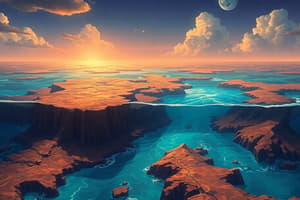Podcast
Questions and Answers
Which type of volcanic rock is characterized by high silica content and cools quickly on the surface?
Which type of volcanic rock is characterized by high silica content and cools quickly on the surface?
- Andesitic Lava
- Gabbroic Rock
- Basaltic Lava
- Rhyolitic Lava (correct)
What process causes the ocean floor to age and increase in distance from a mid-ocean ridge?
What process causes the ocean floor to age and increase in distance from a mid-ocean ridge?
- Continental drift
- Subduction
- Seafloor spreading (correct)
- Volcanic Aactivity
What phenomenon was crucial for affirming the theory of Pangea after World War II?
What phenomenon was crucial for affirming the theory of Pangea after World War II?
- The evidence of seafloor spreading (correct)
- The identification of continental rifting
- The discovery of hot spots
- The mapping of stratovolcanoes
Where do stratovolcanoes primarily form, and what is their structural characteristic?
Where do stratovolcanoes primarily form, and what is their structural characteristic?
What occurs at a continental rifting site?
What occurs at a continental rifting site?
Which process primarily contributes to the formation of new oceanic crust?
Which process primarily contributes to the formation of new oceanic crust?
What is the significance of metallic particles in magma during seafloor spreading?
What is the significance of metallic particles in magma during seafloor spreading?
What type of volcanic rock is classified as 'thick' and comes from volcanic vents?
What type of volcanic rock is classified as 'thick' and comes from volcanic vents?
How does the age of the oceanic floor change in relation to a mid-ocean ridge?
How does the age of the oceanic floor change in relation to a mid-ocean ridge?
What primarily causes the formation of reverse faults in the Earth's crust?
What primarily causes the formation of reverse faults in the Earth's crust?
At what dip angle do reverse faults generally occur?
At what dip angle do reverse faults generally occur?
Which mountain range formation was significantly influenced by reverse faults?
Which mountain range formation was significantly influenced by reverse faults?
What geological phenomenon is often associated with reverse faults?
What geological phenomenon is often associated with reverse faults?
How do reverse faults differ from normal faults in terms of hanging wall movement?
How do reverse faults differ from normal faults in terms of hanging wall movement?
What type of tectonic plate interaction is commonly associated with reverse faults?
What type of tectonic plate interaction is commonly associated with reverse faults?
What is a key difference in stress environment between reverse faults and normal faults?
What is a key difference in stress environment between reverse faults and normal faults?
What type of fault typically has a dip angle less than 30 degrees?
What type of fault typically has a dip angle less than 30 degrees?
Flashcards are hidden until you start studying
Study Notes
Seafloor Spreading
- New oceanic crust is formed at mid-ocean ridges due to divergent plate boundaries.
- The age of the oceanic floor increases as distance from the ridge increases.
- Metallic particles in magma align with the Earth's magnetic poles, creating normal or reverse polarities.
- Normal polarity: Magnetic field aligned with the North Pole.
- Reverse polarity: Magnetic field aligned with the South Pole.
- Most of Earth's internal heat escapes through mid-ocean ridges.
- Pangea broke up about 175 million years ago.
Continental Rifting
- Continental rifting is a divergent plate boundary.
- Plates pull apart, causing the surface to warp upwards and crack.
- Magma wells up through cracks, forming extrusive rock and potentially new oceanic crust.
- Rhyolitic lava is extrusive igneous rock that cools quickly on the surface, rich in silica.
- Andesitic lava is hard, thick extrusive rock formed from volcanic vents.
Volcanoes and Plate Boundaries
- Composite volcanoes (stratovolcanoes) are formed by subduction zones, characterized by layered ash and molten rock.
- The Hawaiian Islands were formed by hotspots.
- Hotspots cause continental break-up by creating rising magma plumes that crack the Earth's crust.
- The Himalayas were formed by convergent boundaries.
- Subduction causes suturing during convergent continental plate boundaries.
Earth's Structure
- The asthenosphere is a thin layer in the upper mantle.
- The lithosphere contains the Earth's crust.
Mid-Oceanic Ridges
- Seafloor Spreading: New oceanic crust is formed at mid-ocean ridges due to the separation of tectonic plates.
- Age of Oceanic Floor: The further away from a mid-ocean ridge, the older the oceanic floor.
- Magnetic Polarity: Metallic particles in magma align with the Earth's magnetic poles, creating a record of past magnetic field reversals.
- Normal Polarity: Magnetic field aligned with the North Pole.
- Reverse Polarity: Magnetic field aligned with the South Pole.
Continental Rifting
- Divergent Plate Boundary: Plates pull apart, causing the Earth's crust to rise, crack, and allow magma to well up, forming new oceanic crust.
- Extrusive Rock: Rhyolitic (silica-rich) and andesitic lavas erupt from volcanic vents and cool rapidly on the surface.
Volcanoes
- Composite Volcanoes: Formed by subduction zones, these stratovolcanoes have layers of ash and molten rock.
- Hot Spots: Plumes of rising magma from the Earth's mantle can create chains of volcanic islands (e.g., Hawaii).
- Continental Break-up: Hot spots can cause continental plates to break apart, forming new oceanic crust.
Mountain Formation
- Convergent Plate Boundaries: The collision of tectonic plates results in the formation of mountains (e.g., Himalayas).
- Subduction Zones: One plate slides beneath another, causing the overriding plate to buckle and uplift, creating mountains.
Earth's Layers
- Asthenosphere: A thin, partially molten layer in the upper mantle that allows tectonic plates to move.
- Lithosphere: Includes the Earth's crust and the rigid upper layer of the mantle.
Reverse Fault Mechanics
- Reverse faults are characterized by the hanging wall moving upward relative to the footwall.
- This occurs due to compressional forces in the Earth's crust, squeezing rocks together.
- Reverse faults generally have steep dip angles (greater than 30 degrees).
- If the Dip angle is less than 30 degrees, it is considered a thrust fault.
- The movement along reverse faults is typically vertical.
Examples of Reverse Faults
- The formation of the Himalayan Mountains is a result of the collision between the Indian and Eurasian tectonic plates, generating significant reverse faulting.
- The San Andreas Fault exhibits a reverse faulting component in certain areas.
- The Rocky Mountains formation involves numerous reverse faults, uplifting older rocks over younger layers.
- Subduction zones, where one tectonic plate is forced beneath another, typically display reverse faulting.
Geological Implications of Reverse Faults
- Reverse faults contribute to the formation of mountain ranges and complex geological structures.
- They are often associated with substantial seismic events due to the buildup of stress from compressional forces.
- Reverse faults can lead to folding and faulting of rocks, providing insights into past geological processes and stress regimes.
- They can influence the distribution of mineral deposits and hydrocarbon reservoirs.
Reverse Faults vs Normal Faults
- Movement Direction: Reverse faults have upward movement of the hanging wall, while normal faults exhibit downward movement.
- Stress Environment: Reverse faults are formed under compressional stress, whereas normal faults develop under extensional stress.
- Dip Angle: Reverse faults typically have steeper dips, while normal faults generally have shallower dips.
- Geological Features: Reverse faults tend to create features associated with uplift, while normal faults contribute to valley formation and basin development.
Studying That Suits You
Use AI to generate personalized quizzes and flashcards to suit your learning preferences.




